Saturday, April 23: Here Comes the Sun
Our final day in Prague was spectacular. Illuminated by bright sunlight, the architecture of the city popped against a crisp blue canvas of sky. We explored the city for much of the day before the musicians began their rehearsal in Smetana Hall. The final concert started promptly after dinner and it was a triumphant performance in a magnificent auditorium before an audience of 800. Saturday was truly the grand finale of our trip.
Dvorak Museum
 |
| Prague train station. |
 |
| Dvorak Museum. |
Renowned Czech composer Antonin Dvorak (1841 - 1904) got his start by submitting a composition to a contest. The work so impressed Johannes Brahms that Brahms recommended Dvorak to his publisher. At the time, this was roughly equivalent to getting a record contract. Recognized along with Smetana as one of the great Czech composers, Dvorak is known for many works including New World Symphony, The Slavonic Dances (a portion of which was included on the HYSO program for this tour), and the opera, Rusalka.
Located in Prague, the Dvorak Museum strives to preserve the legacy of this great composer. Curiously, Dvorak never had an association with this house. It is an early 18th century home that coincidentally carries the name of the land that inspired Dvorak's 9th symphony: Amerika.
 |
| A viola owned by Dvorak. |
 |
| A Viennese-crafted 1879 Bosendorfer piano owned by Dvorak. |
 |
| Rear of the Dvorak Museum. |
 |
| Erica, The Bear, and Izzy squinting into the sun at the Dvorak Museum. |
Lesser Quarter
The Lesser Quarter (also known as the Little Quarter) of Prague is the portion of the city between the west bank of the Vltava River and the base of Prague Castle. The neighborhood was founded in 1257.
 |
| Looking across the Vltava toward Old Town. |
The Charles Bridge spanning the Vltava is one of the city's most famous landmarks. Completed in 1405 after 45 years of construction, it was once the only means across the Vltava in Prague. It directly connects the Castle District / Lesser Quarter to Old Town. Originally called the Stone Bridge, it is now known as the Charles Bridge in honor of King Charles IV who commissioned it. Today, it is routinely thronged by tourists. This was one of the few places where we were specifically cautioned to be on the lookout for pickpockets. Even from this distance, it was obvious that the population density is high.
From left to right, the large dark tower is the Old Town Bridge Tower that marks the Old Town end of the Charles Bridge, the copper dome belongs to the St. Francis of Assisi Church, and the clock tower is attached to the Old Town Water Works.
Czech sculptor David Cerny's Miminka (babies), infants whose faces have been horrifically replaced with bar codes, are internationally notorious. Their 2000 debut in Prague featured fiberglass versions crawling up the jarringly discordant structure of the Zizkov Television Tower. On Friday, we heard Otto talk sufficiently about "the babies" that we all recognized them for what they were as soon as they came into sight. They are gloriously hideous.
 |
| The French Embassy in Prague. |
Across the street from the French embassy is Prague's famous Lennon Wall. Starting in the 1980s, it has borne Beatles-inspired messages of peace rendered in graffiti. John Lennon’s viewpoints resonated strongly with the youth of Prague oppressed under communist authority during the 1980s.
To perpetuate an ongoing theme. If the hair fits...
 |
| The HYSO at the Lennon Wall. Photo by Kristen. |
 |
| The Bear posing with the HYSO at the Lennon Wall. |
 |
| Izzy and The Bear at the Lennon Wall. |
 |
| Izzy, The Bear, and me at the Lennon Wall. Photo by Kristen. |
The Charles Bridge
We made our way to the Charles Bridge via stairs on the Lesser Quarter side.
 |
| The Lesser Quarter Bridge Tower that Yana, Zhenya, and I passed beneath the day before. |
 |
| The Lesser Quarter Bridge Tower with St. Vitus visible higher up on the hill. |
Placed in 1683, this statue of St. John of Nepomuk is the oldest on the Charles Bridge. It honors the priest who was murdered by the King and summarily thrown into the Vltava from the Charles Bridge in 1393. His was the massive silver tomb that we saw in St. Vitus the previous day.
 |
| Crossing the Charles Bridge back toward Old Town. |
 |
| The Rudolfinum. |
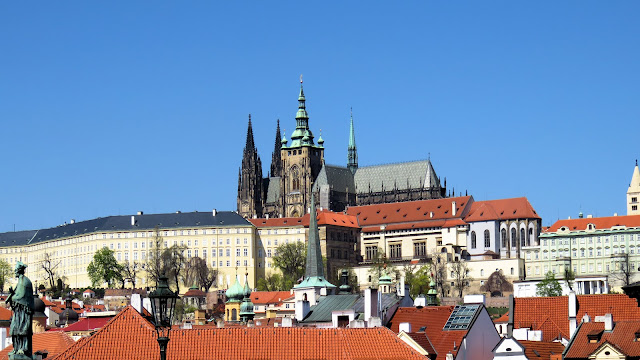 |
| St. Vitus from the Charles Bridge. |
Return to Old Town
We reached the eastern side of the Charles Bridge and passed beneath the Old Town Bridge Tower.
The St. Francis of Assisi Church was built in 1688. It is famous for its still functional pipe organ. Dating to 1702, it is the second oldest organ in Prague (the oldest is in the Tyn Church near the town square) and has been played by the likes of Mozart and Dvorak.
 |
| Old Town Bridge Tower. |
King Charles IV (1316 - 1378) was the first Bohemian king to be named Holy Roman Emperor and, during his reign, Prague became the capital of the Empire. His patronage is credited with many structures and institutions within Prague, including the bridge we had just crossed.
Originally founded by Jesuits, the Church of St. Salvador was built over a number of years ranging from 1578 to 1654.
 |
| Old Town Bridge Tower. |
Klementinum
 |
| Clock tower at the Klementinum. |
Next, we entered the former Jesuit complex known as the Klementinum. After serving as a university, it is now home to the National Library of the Czech Republic and considered one of the most beautiful libraries in the world. It is a shame that we did not get to go inside because the pictures I have seen are breathtaking.
The Astronomical Tower was built in 1722 to support the astronomy curriculum of the university. At the time, noted astronomers Tycho Brahe and Johannes Kepler actively worked in Prague. The tower was also used to capture weather observations, creating one of the oldest contiguous weather records in the world. Starting in 1848, astronomers in the tower kept time for the city of Prague by measuring the movement of sunlight. A lead statue of Atlas bearing the celestial sphere stands atop the 68 meter tower.
We emerged from the Klementinum to see the New City Hall. From here, Izzy, The Bear, and I went in search of lunch.
We were reunited with The Reader and set our sights on Meet Burger for lunch.
I confess to being very surprised by the amount of English signage in Prague. Then again, maybe this is just a place intended to appeal to English-speaking tourists.
 |
| "Go up in the Astronomical Tower? Um...yes!" |
During lunch, we learned from Yana that tours to the top of the Astronomical Clock tower were available. Izzy and The Bear were in without hesitation. We learned about this from the Yana-initiated group chat called, "[Hogwarts] Mafia Conquers Germany". This was how Yana and I sent real-time photos back to the rest of the Hogwarts parents in the US throughout the trip.
Throughout the day, we learned that some of the HYSO musicians had become sick and stayed behind at the hotel. Initially miscommunicated as Covid, we later learned that there was a GI bug making the rounds. Fortunately, none of the Hogwarts students were affected.
From the Top of the Astronomical Clock Tower
We returned to the Old Town Square and entered the Astronomical Clock building. The observation level is visible as a series of arched windows above the conventional clock and below the tower roof.
 |
| Church of Our Lady before Tyn. |
 |
| Astronomical Clock. |
 |
| Astronomical Clock. |
The expensive tickets involved an elevator ride though this central shaft to the top. But we cheaped-out and climbed the ramp that “spiraled” to the top. (Can something with a square cross section be considered a spiral? Maybe only in Minecraft.) A narrow spiral stair (far left of frame) brought us the last 20 feet to the top. It was a little angst inducing and we had to wait for a petrified older woman to finally clear the stairs before we could proceed.
It is most certainly a long way down.
We emerged onto the roof of the city.
And the view was magnificent. This was truly the most beautiful part of our entire trip.
Looking westward, we could see the Old Town and Lesser Quarter Bridge Towers, a portion of the Charles Bridge, the Astronomical Tower at the Klementinum, and of course the massive St. Vitus cathedral within the walls of Prague Castle.
Despite our significant elevation atop the Astronomical Clock, we were still looking up at Prague Castle and St. Vitus.
This was quite the party spot. It reminded me of some of the rooftop dining options in Maine fishing villages, but much nicer.
 |
| The Klementinum Clock Tower, Old Town Bridge Tower, and the Astronomical Tower. |
Our view from the tower gave us an amazing perspective on the familiar Old Town Square.
The Jan Hus Memorial in Old Town Square.
 |
| St. Nicholas' Church. |
 |
| The Bear and Izzy enjoying the view. |
The communist era Zizkov TV tower in Prague was once voted by VirtualTourist.com (now defunct) as the second ugliest building in the world. (The ugliest, a theater in Baltimore, has since been demolished.) To be sure, this massive reminder of the communist era rises disharmoniously above the classically beautiful city. Considered an eyesore by many, more examples of sculptor David Cerny's grotesque Miminka (babies) can be seen crawling on the structure. Those are some big babies.
 |
| Church of Our Lady before Tyn. |
 |
| Church of Our Lady before Tyn. |
 |
| The entire Old Town Square with the Easter Market still going full swing. |
 |
| Back on the ground in front of St. Nicholas' Church. |
The Astronomical Clock Tower stands atop the former city hall building. From here, we corralled the HYSO musicians and herded them toward Smetana Hall for rehearsal, dinner, and the HYSO's final performance.
Prague's giant metronome stands on the former site of a monument to Soviet leader Josef Stalin. It is fully functional and keeps time at four beats per minute. The Ukrainian flag is a more recent addition.
The Municipal House and Smetana Hall
The Municipal House contains Smetana Hall as well as dining and shopping opportunities.
 |
| Panorama of the Municipal House. |
While the musicians rehearsed, the parents sat outside and enjoyed drinks and conversation.
 |
| The Hogwarts table: Zhenya, Yana, Luke, Izzy, The Bear, and me. Gabe was hanging out with the cool kids. Photo by Kristen. |
Our final dinner in Europe was at the Restaurant Plzenska in the basement of the municipal house. We were rejoined by some of the ill musicians, some of whom were ready to play, though not fully recovered. The principal trumpet's color was definitely off.
 |
| The Bear and me. Photo by Kristen. |
The Bear was having issues with her reeds and used my phone to videoconference with her teacher back in Rochester. Double reeds like the ones used for oboe require a level of craftsmanship to fabricate and maintain that is not typical of other instruments. Fortunately, Terry was able to coach The Bear through the necessary reed adjustments for her to play with confidence.
Luke proudly sported his new wooden bowtie, a present from Izzy and The Bear purchased in Prague. He was thrilled to have received special dispensation from the HYSO director to wear it for the concert.
When the source material is so odd, it is really difficult to "out-weird" Edward Scissorhands.
Grand Finale
Smetana Hall was breathtaking. I must have been pictured-out because I failed to get any pictures of the HYSO on stage from our balcony seats. Although the GI bug caused some personnel changes during the concert, the HYSO gave a fantastic performance before a massive audience of 800 people. His color may have been off, but the principal trumpet played his solos with power and aplomb. I was impressed.
 |
| Ceiling of Smetana Hall. |
After the concert, as the audience was filtering out, several stopped to offer praise:
"They sound too good to be high school kids!"
"Thank you for coming! We were so disappointed when this was cancelled two years ago!"
The Bear recounted how a little old man approached her and Izzy and, after confirming that they were with the orchestra, profusely complimented them on their playing.
It may have been a rough day for some of the ill musicians, but they truly distinguished themselves.
 |
| Smetana Hall. |
 |
| The by now very familiar Hogwarts contingent with Casey, Director of the HYSO. |
As we departed Smetana Hall, there was no doubt in my mind that we had wrapped up our wonderful journey through Europe with a standout day capped by a magnificent performance.
Our only remaining task was to get ourselves home.
The first step was setting an alarm for 2:00 am.














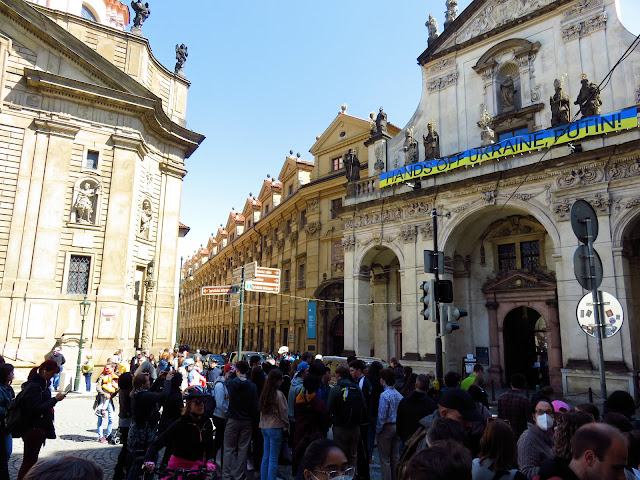






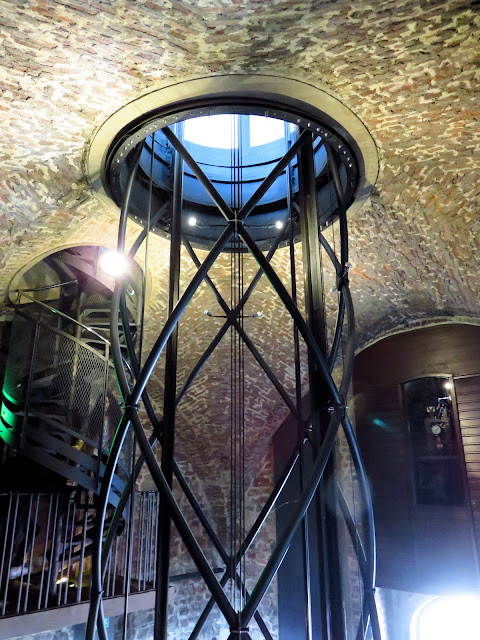
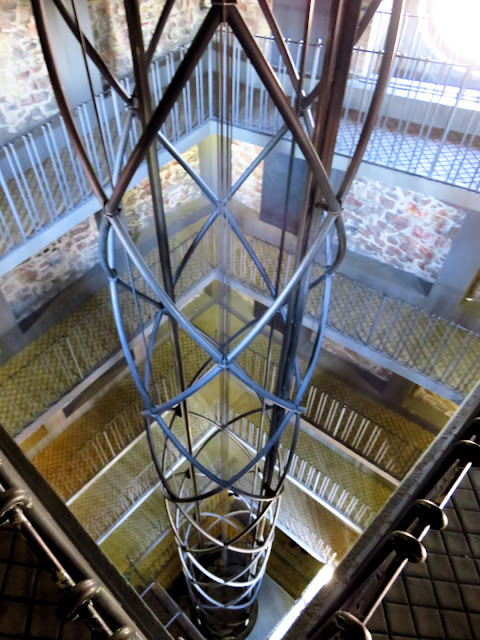



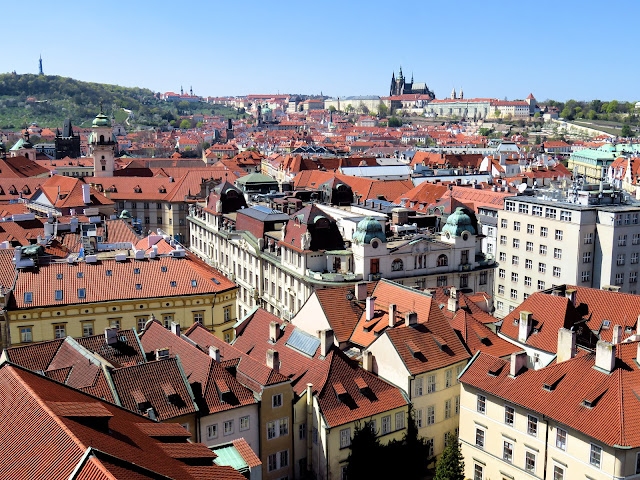


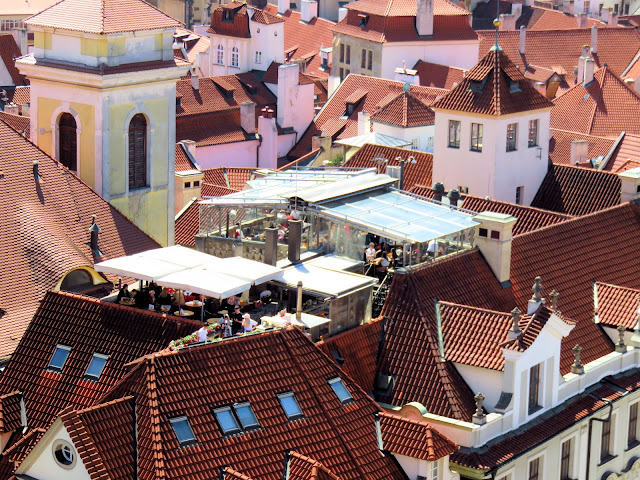










No comments:
Post a Comment